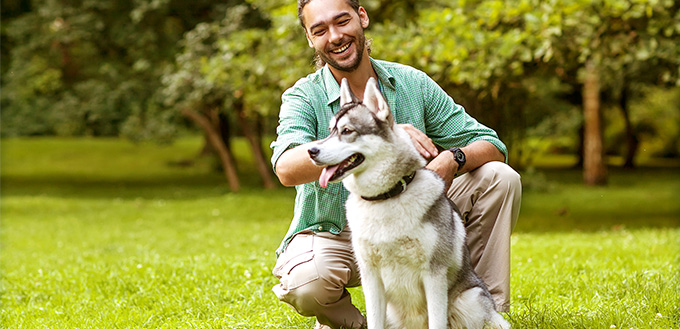Training your dog has plenty of benefits. Improving their behavior, strengthening the bond between the two of you, keeping their brain sharp, and simply showing off are three of the main ones! When people are first getting started down this road, they are likely, to begin with, basic commands such as ‘sit’ and ‘stay’, but are you ready to move onto the ‘speak’ command?
There are plenty of direct benefits to controlling your dog’s vocalizations. You can help to prevent any problem barking and limit noise to the times when you ask for it. You can also get your dog to speak if you find yourself saying that my dog won’t bark. Speaking also comes coupled with a ‘quiet’ command, which is useful when your dog becomes overly excitable. So, let’s walk you through some of the steps that can help you in how to teach your dog to speak.

Step-by-Step Dog Speaking Guide
-
Step One: Get Your Dog Excited
To train your dog in the speak command, you are going to need to get them excited in the first place. You can do this by getting excited yourself and getting your dog to match your enthusiasm. A couple of ways that you can amp up excitement levels include playing a couple of high-energy games such as a tug of war or fetch. Essentially, you are trying to get your dog excited enough that they are going to do some barking.
Take a look at our article on Automatic Fetch Machines.
-
Step Two: Show Your Dog a Treat
Now, you are going to need an object that is going to elicit a bark from your dog. Perhaps this could be one of their favorite dog toys, a ball, or a dog treat. You will need to show it to them, but don’t offer it just yet. Instead, you can quickly hide it behind your back. Your dog may start to make a whimpering sound when the exciting object disappears, so you can show it once again.
-
Step Three: Reward the Barking
While this may seem like counterintuitive behavior, you now need to reward your dog’s barking. Hopefully, the high-energy games and the sight of a treat should have increased the chances that they are going to bark. In order to make the association in your pooch’s mind, you need to say something positive like ‘yes’ or ‘good’ in the right tone of voice. You can then reward your dog with the treat or object of their desire. If you are struggling to get your dog to bark, a possible solution is to do some barking yourself. While you may feel a little silly, they may start copying your behavior.
-
Step Four: Link the Bark with a Command
Now, the time has come for you to link your dog’s barking with a specific command or hand signal. Many people choose to use the simple ‘speak’ command right before he or she barks. The hand signal approach is popular as these are recognizable by canines. You just need to make sure that you choose something unique. Soon, your dog should learn that barking is what you want from them. Some pooches will understand from just a few associations, whereas others will require you to work just a little bit harder than that.
-
Step Five: Repetition, Repetition, Repetition
One of the founding principles of dog training is that you need to be consistent and repeat your actions again and again until your hound gets it. Continue repeating the sequence of instructions that we have discussed above. Soon, you should be able to use the command with no prompting needed and your dog will bark for you. You should also try to phase out the treats as these can end up distracting your pup and slowing down the time in which they respond. You can gradually start to increase the number of correct behaviors before you offer a treat. The other thing that you can do is to lengthen the amount of time before giving out the reward. Also, try using other things than food. For example, try praising your pooch, petting them, playing with them, and simply showing them the love and attention that they deserve.
-
Step Six: Practice in Different Situations
When you think that your dog is getting good at speaking, this is the time that you can really test them out in different situations with a variety of distractions in front of them. Demonstrate your dog’s new skill in front of your friends and in public where there is a lot more going on around you. You may also need to hone your dog’s skills. When your pooch speaks, they should only bark a few times. You don’t want them to keep barking and barking with no end! You may be able to put a stop to it by adding another command at the end that lets your dog know that it is time to stop. A simple ‘no more’ is concise and to the point. You need to be careful that you don’t turn the speak command into problem barking.
Extra Tips
If you need a couple of extra pointers, there are one or two further points that can prove to be useful. While it may seem obvious, it is still worth mentioning, nevertheless. You shouldn’t reward barking unless you have specifically directed your dog to speak. This is the kind of behavior that is likely to lead to the aforementioned problem barking. As we mentioned above, try to cut short your dog’s barking at only a single one or a couple.
Another possibility is to try clicker training. This is a popular technique that involves you using the sound of a training clicker to let your dog know when they have done the right thing. Many people believe that it works as the sound that it makes is distinct from your voice and your pooch can easily develop an association with it.

Teaching the ‘Quiet’ Command
Many people decide that the best thing to do is to start off with a ‘quiet’ command before they teach their dog to speak. After all, the two should go hand in hand. If your dog is very loud, it makes sense that you start off with this one. As usual, you are going to need plenty of treats ready to go. Before you give any treats, you need to ensure that you only offer them in quiet moments. Some people prefer to use a clicker when they are doing this, while others prefer to rely on a ‘yes’ command. You may need to start with just a moment of quiet before you can start to reward longer moments of calm.
Along with the rewards, you will need to add a simple ‘quiet’ command. You need to ensure that they are comfortable with the behavior, before slowly moving the cue back until you are offering it before the behavior. Soon, your dog should start to learn that he or she will only receive a reward when no sound is made.
Reasons to Teach Your Dog to Bark
Now that we have given you a simple step-by-step guide on how to teach your dog to speak, you may be looking for a few reasons why you would want to do this in the first place. Well, it certainly comes with its share of advantages in ensuring a harmonious relationship between the two of you.
- Your Dog Can Communicate Better
While there is nothing yet that is going to adequately bridge the gap between dog vocalizations and human speaking, teaching your dog to speak can help in certain situations such as letting you know when they need to go outside to use the bathroom. This can help to prevent any accidents indoors. Bear in mind that this is likely to require some additional training sessions before your dog learns that they need to ask to be let outdoors.
- Quieten Down Your Dog
When your dog has become quite adept at speaking, you can then use this technique to adjust its barking. For example, if they have overly rough or loud-sounding bark, you can soften this out by teaching them to whisper. You can also silence them all together with a ‘quiet’ command.
- Teach Your Dog to Announce Visitors
Many dogs will go crazy when visitors arrive anyway but teaching them to bark in a controlled manner can be useful for home security. Again some additional training is likely to be needed for you to have the success that you are looking for.

Final Thoughts
Teaching your dog the ‘speak’ command is a simple technique, but it is one that will prove to be invaluable in your future relationship together. Hopefully, the above step-by-step guide helps you in your quest to do this. You can also teach your dog the ‘quiet’ command as a way of further controlling their vocalizations. Increasing the number of your commands in your dog’s repertoire helps to stamp out any problem behavior, as well as strengthening the bond between the two of you.
Sources:
- Clarissa Fallis, 6 Tips on Teaching Your Dog to Speak, Petful
- Lynn Buzhardt, DVM, Human-Canine Communication: Tone vs. Volume, VCA Hospitals







